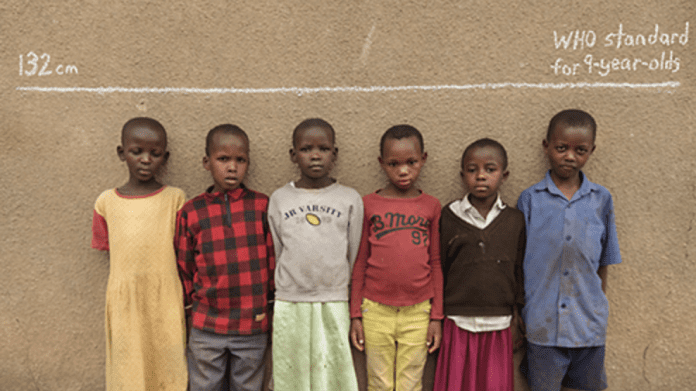Nearly one in every five Ghanaian children under age five is stunted, affecting their brain development and future productivity, according to UNICEF reports on child malnutrition in the country.
The revelation highlights a persistent nutrition crisis that, while showing improvement compared to regional averages, continues to threaten the long term prospects of thousands of Ghanaian children. Current data shows 17.5% of children under five years of age are affected by stunting, a condition resulting from chronic undernutrition during the critical early years of development.
Access to safe, sufficient, and nutritious food is recognized as a fundamental human right. Yet in Ghana, malnutrition is not evenly distributed, affecting some groups far more than others. Rural children, those from poorer households, and children whose mothers have limited education bear a disproportionate burden of this nutritional inequality.
Stunting occurs when children don’t receive adequate nutrition over an extended period, causing them to be too short for their age. The consequences extend far beyond physical stature. Stunted children often experience impaired cognitive development, reduced immunity to diseases, and diminished learning capacity that follows them into adulthood.
Beyond stunting, one in every ten children under five is underweight, adding another dimension to Ghana’s malnutrition challenge. These statistics paint a picture of a country making progress but still struggling to ensure all children receive the nutrition they need to thrive.
The most alarming finding concerns infant and toddler feeding practices. Almost two in three children between six months and two years of age are not fed food that supports their rapidly growing bodies and brains. This critical period represents a window of opportunity where proper nutrition can set the foundation for lifelong health and development.
Poor dietary diversity during this crucial phase means many young children subsist on monotonous diets lacking essential vitamins, minerals, and proteins. The impact of inadequate nutrition during these formative months can prove irreversible, affecting children’s physical growth, cognitive abilities, and future earning potential.
While Ghana’s stunting rate shows the country is performing better than many of its regional neighbors, the figure remains below the Africa region average of 30.7%. However, this relative success shouldn’t obscure the reality that hundreds of thousands of Ghanaian children still face nutritional deprivation.
The malnutrition crisis presents a paradox in a country experiencing economic growth and development. Ghana has made notable strides in reducing poverty and improving healthcare access, yet the persistence of child malnutrition suggests that growth hasn’t translated uniformly into better nutrition outcomes for all families.
Several factors drive this nutritional inequality. Poor food environments in certain communities limit access to diverse, nutritious foods. Economic constraints force families to prioritize cheaper, less nutritious options. Limited nutrition knowledge among caregivers leads to suboptimal feeding practices, even when resources are available.
Additionally, 6.8% of children under five years of age are affected by wasting, a more acute form of malnutrition that indicates recent and severe weight loss. Wasting reflects current nutritional stress and often results from illness or inadequate food intake.
The dual burden of malnutrition adds complexity to Ghana’s nutrition landscape. While undernutrition persists, overweight and obesity are also emerging concerns, particularly in urban areas. This shift reflects changing dietary patterns as processed foods become more available and affordable.
Ghana has developed various policies and programs to address child malnutrition, including initiatives promoting exclusive breastfeeding, micronutrient supplementation, and nutrition education. The country’s school feeding program reaches millions of children daily, providing at least one nutritious meal to pupils in vulnerable communities.
Despite these efforts, implementation challenges, funding constraints, and gaps in coverage limit their effectiveness. Many rural and hard to reach communities lack consistent access to nutrition services and support programs that could prevent malnutrition.
The economic implications of child malnutrition extend beyond individual health outcomes. Stunted children typically perform worse in school, complete fewer years of education, and earn less as adults. This cycle perpetuates poverty and limits the country’s human capital development.
Research has shown that every dollar invested in nutrition during early childhood generates significant returns through improved health, increased educational attainment, and higher productivity. Addressing malnutrition isn’t just a moral imperative but an economic necessity for Ghana’s development trajectory.
The COVID-19 pandemic’s economic disruption exacerbated food insecurity for many Ghanaian families, potentially reversing some gains made in recent years. Rising food prices, income losses, and disrupted health services created additional challenges for families already struggling to meet their children’s nutritional needs.
Climate change poses another threat to child nutrition in Ghana. Changing rainfall patterns, increased flooding, and prolonged droughts affect agricultural productivity and food availability, particularly in vulnerable regions. These environmental challenges make it harder for farming families to produce diverse, nutritious foods.
Ending child malnutrition in Ghana requires a multifaceted approach. Strengthening social protection programs can help poor families afford nutritious foods. Improving agricultural systems to increase production of diverse crops can enhance food availability. Expanding nutrition education helps caregivers make informed choices about feeding practices.
Healthcare system strengthening is equally important. Regular growth monitoring, early detection of malnutrition, and timely intervention can prevent mild cases from becoming severe. Community health workers play a vital role in reaching families with nutrition counseling and support.
The statistics on Ghanaian child malnutrition serve as both a challenge and a call to action. While progress has been made, the fact that one in five children remains stunted indicates much work remains. Ensuring every Ghanaian child receives adequate nutrition to reach their full potential must remain a national priority.
Source: newsghana.com.gh











